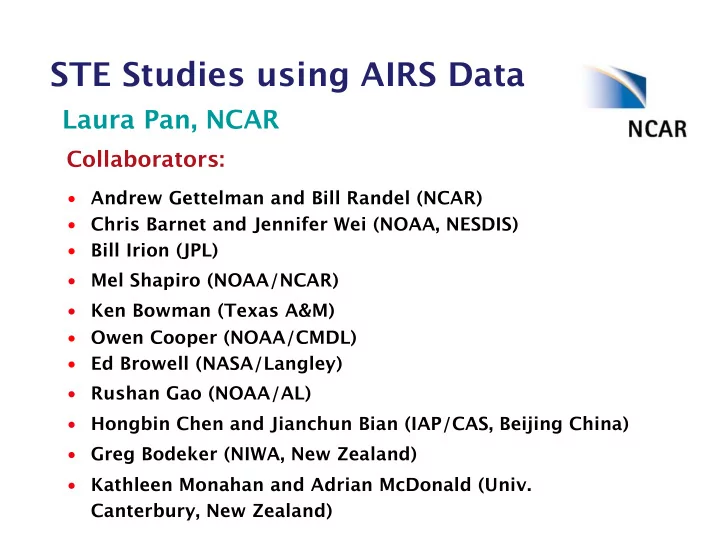

STE Studies using AIRS Data Laura Pan, NCAR Collaborators: • Andrew Gettelman and Bill Randel (NCAR) • Chris Barnet and Jennifer Wei (NOAA, NESDIS) • Bill Irion (JPL) • Mel Shapiro (NOAA/NCAR) • Ken Bowman (Texas A&M) • Owen Cooper (NOAA/CMDL) • Ed Browell (NASA/Langley) • Rushan Gao (NOAA/AL) • Hongbin Chen and Jianchun Bian (IAP/CAS, Beijing China) • Greg Bodeker (NIWA, New Zealand) • Kathleen Monahan and Adrian McDonald (Univ. Canterbury, New Zealand)
Upper Troposphere & Lower Stratosphere - A region of coupled dynamics, chemistry and cloud microphysics
Scientific Motivations Scientific Motivations Challenges of quantifying STE of chemical Challenges of quantifying STE of chemical tracers (ozone, water vapor, and more ) tracers (ozone, water vapor, and more ) • When - seasonality, • When - seasonality, • Where- preferred locations, • Where- preferred locations, • How - the controlling processes, • How - the controlling processes, • How much - e.g. how much does STE • How much - e.g. how much does STE contribute to the UT ozone and LS contribute to the UT ozone and LS water vapor? water vapor?
Initial results Initial results Validation analyses of AIRS UTLS Validation analyses of AIRS UTLS ozone ozone Diagnosing STE using AIRS ozone Diagnosing STE using AIRS ozone and water vapor data and water vapor data
AIRS Ozone on 250 hPa (in 1x1 degree average) May 15, 2004 Monthly mean May, 2004
Before AIRS NASA Langley DIAL (Ed Browell ‘s group)
Tropopause DC-8 alt
AIRS Ozone Cross Section (1x1 degree average) May 15, 2004, Lon=160 E
Is AIRS ozone data meaningful, especially in the tropopause region? Case studies using aircraft data: • In situ, NOAA G4 Hawaii, Feb 2004 • LIDAR NASA DC8 PAVE, Jan 2005 • In situ NASA WB57 AVE Houston, Nov 2004 • In situ NSF G5, START, Dec 2005 Statistical comparisons using ozonesondes • Beijing, China • Lauder, New Zealand
Case 1: NOAA G4, Hawaii Feb 2004 NH cross-sections Feb 29, 2004 GIV measurements Feb 29, 2004 Cooper et al., [ 2005]
Case 2: NASA WB57 AVE mission Houston, Nov 2004 (black line is the flight track, AIRS cross section on right )
AIRS interp B57 in situ on the flight track The agreement between AIRS and in situ between 50-500 ppb is remarkable
Case 3: NASA Langley DIAL, DC-8 PAVE Jan 2005
HIAPER Progressive Science Mission (22 November- 23 December, 2005) Daybreak before take off 2005-12-21
Stratosphere-Troposphere Analyses Stratosphere-Troposphere Analyses of Regional Transport (START) of Regional Transport (START) Experiment Experiment Investigators: Investigators: Collaborators: Collaborators: Laura Pan (PI, ACD/TIIMES) Chris Barnet Ken Bowman (Texas A&M) Jennifer Wei Mel Shapiro (NOAA/NCAR M M M ) (NOAA/NESDIS Bill Randel (ACD) Satellite data) Rushan Gao (NOAA) Teresa Campos (ACD/EOL) Chris Davis (MMM) Sue Schau ffl er (ACD) Frontal Cloud - flt 2005-12-14
Case 4: START Flight 2 (2005-12-07) Hunt for Intrusion
Planned 1st Flight Nov 23, 2005
X
A stable layer
Comparisons with ozonesondes over Beijing • Work of J. Bian and H. Chen (in colaboration with NCAR group) • Data from Sept 2002 - July 2005, over 70 profiles • Examples and statistics
20050223 20041008 10 10 pressure (mb) pressure (mb) 100 100 1000 1000 0 40 80 120 160 200 0 40 80 120 160 200 ozone partial pressure (nb) 20050316 20050413 ozone partial pressure (nb) 10 10 pressure (mb) pressure (mb) 100 100 1000 1000 0 40 80 120 160 200 0 40 80 120 160 200 ozone partial pressure (nb) ozone partial pressure (nb)
Statistics of 70+ Pairs AIRS V4 all samples AIRS V4 all samples 10 10 Pressure (hPa) Pressure (hPa) 100 100 Ozonesonde AIRS V4 1000 1000 0 50 100 150 200 250 -100 0 100 200 300 Ozone partial pressure (nb) (AIRS - SONDE)/SONDE (%)
Comparisons with ozonesondes over Lauder • Work of K. Monahan (Canterbury U. NZ) • Data from December 2004 - November 2005, 48 profiles
AIRS-Sondes 0-10 ppmv range
0-1.5 ppmv range (UTLS)
Summary of Validation Analyses • High degree of consistency with dynamical variability of UTLS • Realistically map chemical transitions between stratosphere and troposphere • • Show reasonable agreement with aircraft data over a large dynamical range of ozone • Initial comparisons with ozonesonde show good agreement between 400-50 hPa range • Both aircraft and sonde comparisons show AIRS ozone data have a tendency of positive bias in the upper troposphere
Unique Strength of AIRS Ozone Data • High spatial density of sampling -> mapping dynamical variability of UTLS chemical distribution • Good vertical resolution near the tropopause -> dynamical processes control STE • Ozone and water vapor -> pair of tracers for diagnosing mixing
Diagnosis of STE • The use of global satellite (AIRS) ozone and water vapor data for STE studies - where is the preferred mixing location and what controls mixing? • Chemical transition across the tropopause using tracer-tracer correlations
Chemical Transition from Tracer-Tracer Correlations (A) (B) Stratosphere Stratospheric tracer or the transition layer Stratospheric tracer Tropopause Troposphere ∆ H T P Tropospheric tracer Tropospheric tracer [Pan et al., 2004]
ER-2 data O 3 -H 2 O (POLARIS)
AIRS O 3 -H 2 O May 15, 2004, 65N
Are these “mixing” points physically meaningful or merely the “smearing” of the retrieval?
Stratosphere Stratospheric tracer “depth” Troposphere Tropospheric tracer Lower boundary of the mixing
AIRS 20040515, “Deep Mixing” diagnosis from O 3 -H 2 O 2,3,4,5 km below TP 3,4,5,6 km mixing depth
AIRS data analyses CLaMS simulations
Diagnosing the Preferred Locations of STE Flux PV “eddies” ERA15 clim. AIRS “Deep Mixing” 200hPa, May 2004 May 2004 Sprenger and Wernli 2003 (JGR)
Work in Progress • Validation papers in progress using in situ and sondes • More validation comparisons with GV data • Chemical transition across the tropopause using tracer-tracer correlations • Comparisons with CCM’s & CTMs
Thank You ! Shadows of Monument Valley - Flight 051209
Recommend
More recommend